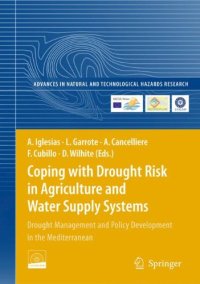
Ebook: Coping with Drought Risk in Agriculture and Water Supply Systems: Drought Management and Policy Development in the Mediterranean
- Genre: Science (General)
- Tags: Environmental Management, Meteorology/Climatology, Ecotoxicology, Waste Water Technology / Water Pollution Control / Water Management / Aquatic Pollution, Human Geography, Climate Change
- Series: Advances in Natural and Technological Hazards Research 26
- Year: 2009
- Publisher: Springer Netherlands
- Edition: 1
- Language: English
- pdf
Today drought causes severe social problems and receives broad attention from the international scientific and policy communities. Drought management in the Mediterranean region exemplifies many other drought-prone regions with rapidly expanding populations that are placing increased pressure on already limited water supplies.
The experiences in the development and implementation of drought management plans in the Mediterranean highlight the success and challenges of coping with drought for societies with different vulnerabilities. Based on these experiences and the current methods for evaluating risk, the book synthesises guidelines for drought management that can be applied to other regions.
Coping with Drought Risk in Agriculture and Water Supply Systems addresses the growing issue of drought preparedness planning, monitoring, and mitigation which has worldwide application. The book collates considerable information from diverse disciplines. The information is presented to appeal to a broad scientific and policy audience seeking to develop proactive drought management plans effective for decreasing social vulnerability.
This book has been written within the framework of the MEDROPLAN (Mediterranean Drought Preparedness and MItigation Planning) Project, co-funded by the European Union through the Euro-Mediterranean Regional Programme for Local Water Management (MEDA Water) and the Mediterranean Agronomic Institute of Zaragoza - CIHEAM (Spain; Coordinator), Universidad Politécnica de Madrid (Spain), University of Cyprus (Cyprus), National Technical University of Athens (Greece), University of Catania (Italy), Institut Agronomique et Vétérinaire Hasan II (Morocco), Canal de Isabel II (Spain), Confederación Hidrográfica del Tajo (Spain), Fundación Ecología y Desarrollo (Spain) and Ministère de l'Agriculture, de l'Environnement et des Ressources Hydrauliques (Tunisia).
Audience:
This book will be of interest to agricultural, water and land managers; policy-makers; researchers in natural hazards and risk management; graduate students in natural hazards, agricultural and water management, rural planning, policy development, and social development.
Over the last three decades drought episodes have resulted in severe social problems in Mediterranean countries, receiving broad attention from the international scientific and policy communities. The experiences in the development and implementation of drought management plans highlight the success and challenges of coping with drought for societies with different vulnerabilities and emphasize risk-based drought management as a critical approach to mitigate the impacts associated to drought-induced water shortages. Based on these experiences and the current methods for evaluating risk, the book synthesises guidelines for drought management that link science and policy and that can be applied to other regions. The book comprises a collection of papers divided into four sections that appeal to a broad audience. First, the social and hydrological context of Mediterranean countries is presented, discussing the interactions that have resulted in the complex institutional framework, and highlighting the importance of stakeholder involvement and awareness building for successful drought management. This section emphasises the role of organizations, institutions, and civil stakeholders involved in drought preparedness and mitigation and/or on water management for designing effective risk based strategies that mitigate the effects of drought in agriculture and water supply systems. Second, the book presents an academic approach to risk evaluation, including characterization of drought episodes, development of indicators of risk in hydrological and agricultural systems, and analysis of the role of economic instruments and groundwater for risk mitigation. This section finalises with the description of an integrated method for evaluating social vulnerability based on indicators that include the capacity to anticipate, cope, and respond to drought. The third section includes a collection of case studies that include the description of effective measures taken in the past. These case studies provide the context for developing demand driven guidelines that may be applied to other regions. The authors of these chapters can be viewed as stakeholders in drought management, since they represent a broad range of sectors and institutions from Mediterranean European and North African countries. The topics addressed have implications for the international policy community interested in disaster mitigation, agricultural policy, and development. Finally a synthesis of the management actions is presented in four chapters. Monitoring and preparedness planning is the essential first step for moving from disaster to risk management in response to drought. The management actions related to agriculture and water supply systems are presented in two different chapters but with a common conceptual framework based on the use of drought indicators for evaluating the levels of drought risk (pre-alert, alert, and emergency), that allow establishing linkages between science and policy. The final chapter discuses the lessons learned and application to other regions.